Hello and welcome to Truth OR Myth, a Star Trek web series that looks at the Truth, or canon, information to dispel the myths that have surfaced on any given topic. In today’s episode, we’re taking a look at the Prometheus Class, in an effort to better understand it’s place in Star Trek history.
A highly experimental and classified design, the Prometheus Class was one of the most advanced starships ever created by Starfleet during the latter half of the 24th century.
With the United Federation Of Planets embroiled in continuous conflicts such as the Dominion War and attacks by the Borg, Starfleet began to develop new classes of Starships designed with only one thing in mind, combat. And the Prometheus Class was one of them.
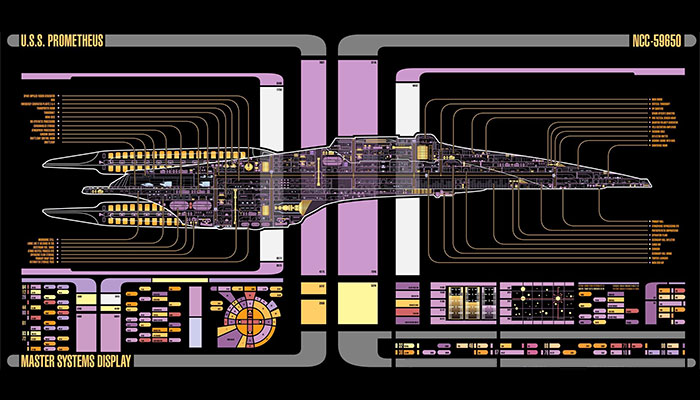
The class prototype, the U.S.S. Prometheus NX-59650, was launched from the Beta Antares Ship Yards on Stardate 50749.5. At the time of its launch, the Prometheus was so highly classified that only four people in all of Starfleet were trained to operate the prototype.
A stark contrast to the regular design of Starfleet starships, the Prometheus Class was approximately 414 meters in length and 16 decks tall. This starship design was also constructed with an unprecedented amount of automated technology. This allowed any starship of the class to be run with a minimal crew, or if required, a single crewman could issue commands to the main computer and the vessel would operate as though it had a full crew aboard. Though it’s standard operating complement was 140 officers and men.
The warp drive of the Prometheus class made its ships faster than any other Starfleet starship in the fleet. It’s newly constructed warp core along with its bio-neural circuitry systems allowed this class to reach and sustain speeds faster than warp 9.9, with a maximum theoretical speed limit of warp 9.99, making it a faster starship class then the Intrepid class which was capable of reaching warp 9.975.
One of the most unique systems of this class was that of the multi-vector assault mode. This new model was based on starship classes like the galaxy class that had the ability to separate its saucer section from its primary hull effectively giving that class 2 potential targets and 2 separate ships to fight with.
However, the Prometheus Class took it one step further. Allowing this class of ship to separate into 3 smaller starships, all of equal strength that had the ability to be controlled by their own crews or from command section itself, these independent sections also had the ability to travel and fight while at warp speed. Though normally only having 4 warp nacelles in operation, during the separation mode the command section had it’s own smaller warp nacelle that would extend allowing its own warp field to be maintained.
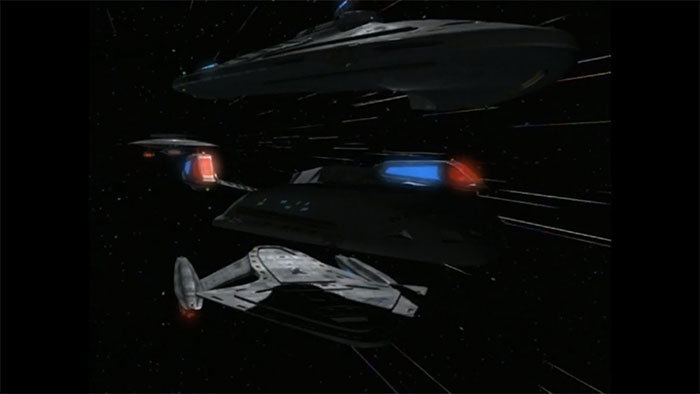
The Prometheus Class also had the most advanced Phaser and torpedo systems of the time. On par with the tactical systems contained within the Sovereign Class, this class could also launch Quantum or Photon Torpedoes as well as being easily adapted for more devastating weapons such as Tri-cobolt devices. This class also had Multi-phasic Regenerative Shields for its own protection, along with Ablative Hull Armour which allowed this class to remain in firefight longer than most other classes.
Another revolutionary design element included in this class was that of the Mark II EMH. Though that system itself was not new, it’s ability to freely travel around the ship was, as holo-emitters were included on every deck in case the hologram was needed in any area of the ship. Though this system is also highly classified the potential of it cannot be ignored. As Starfleet continues to develop automated starships for minimal crews to operate, it could be possible to program and initiate holographic crewmen to supplement starship personnel.
The main bridge of the Prometheus class was located on deck 1 as was the standard traditional placement for the bridge of a Starfleet starship. This bridge design, however, was also a major departure from the look of most starship bridges of the time, being mostly of a white design and containing a vast number of white lights. Bridge stations surrounded the perimeter of the bridge, harking back to an earlier era of Starfleet bridge design, but the command chair, which remained in the centre of the bridge, was actually on the same level as the upper console rim, but simply contained on a pie slice that jetted out from said rim.
The Helm and Navigational Consoles, which could be configured to run all ships systems, were in a combined console contained in a lower pit like a section in front of the Captain. And unlike most starship designs of the time, this class also again harked back to previous starship bridge designs as consoles such as communications were once again their own stations. Access to bridge was achieved by 2 turbolifts, one port and one starboard. And although this class did have both a conference lounge and a captain’s ready room, these areas of the ship were not connected to bridge, rather accessed via the turbolift.
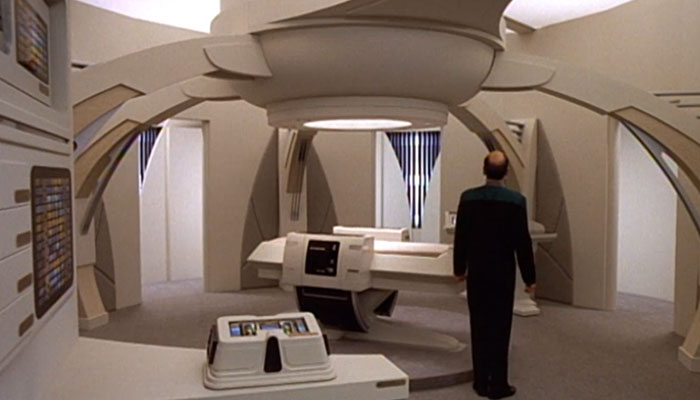
Medical systems aboard the ship were also the most advanced of the time. As stated previously, this design contained the Mark II EMH and was the first starship class to test this new holographic system. Sickbay was also brightly lit in this class, though it was not in the same stark white colour as the bridge, preferring more beige overtones giving a softer look for patients to recover in. This sickbay was also fully stocked with any medical supplies that could be needed in an emergency…
This class also had 1 large shuttlebay capable of carrying a standard compliment of Starfleet Shuttlecraft, pods and worker bees. And also had enough escape pods to evacuate the entire ship even at its maximum capacity.
At its launch it’s dedication plaque read as follows; “All the World’s a stage and all the men and women merely players, they have their exits and entrances and one man in his life plays many parts, his act being seven stages…” – William Shakespeare
Shortly after it’s launch the U.S.S. Prometheus was captured by Romulan Agents who intended on delivering this new class to the Tal Shiar for analysis. Unbeknownst to the Romulan agents however, The U.S.S. Voyager, Under the command of Captain Kathryn Janeway, being stuck in the Delta Quadrant had detected the Prometheus using an alien sensor network and was able to send their own EMH to the Starship in the hopes of making contact with Starfleet command and informing them of their situation. Once onboard the Prometheus, Voyagers EMH, the Doctor, quickly discovered the vessel was no longer under Starfleet’s control and activating Prometheus’s EMH Mark II, the 2 quickly devised a plan to recapture the ship from the Romulans.
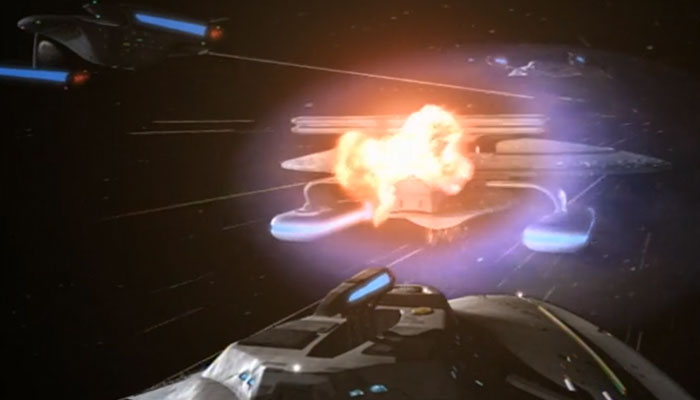
Meanwhile, Starfleet Command, in response to the ship being captured sent starships to intercept the now enemy vessel in its own hopes to recapture the vessel. One ship the U.S.S. Bonchune NCC-70915, was the first to intercept the vessel but was easily disabled when the Romulans used the Multi-Vector Assault Mode to attack the ship. Voyager’s EMH, acting as though he was actually Prometheus’s EMH was discovered by the Romulans attempting to access Prometheus’s environmental systems. The Romulans, in turn, discovered that the Doctor had been sent by what they believed to be Starfleet, via a subspace transmission.
Showing his ability to adapt to this new situation however, the EMH Mark II, was able to fool the Prometheus’s sensors in to believing there was a macrobiotic contamination on all decks which automatically released the environmental systems the doctor had been originally trying to access and allowed the EMH Mark II to anaesthetize the entire complement aboard the Prometheus.
Then the 2 holograms attempted to take control of the ship, however, not being fully versed in the functioning of this class, that proved harder than both EMH’s hoped. Though they were able to stop the ship itself, the Tal Shiar, via 3 Romulan Warbirds quickly caught up with the Prometheus and demanded her surrender. But luckily for the holograms, Starfleet 2nd task force sent to intercept the Prometheus also arrived. This task force consisted of 2 defiant Class ships as well as 1 Akira class Starship and with the eventual help of the Prometheus itself and it’s Multi-Vector Assault Mode, the holograms were able to return control of the Prometheus back to Starfleet Command.
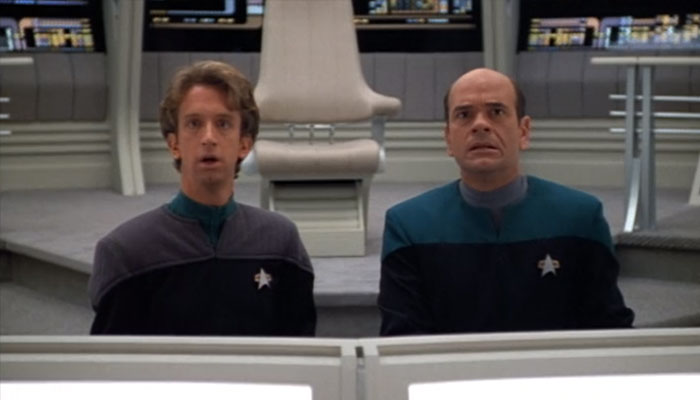
Subsequently, Starfleet was informed of the U.S.S. Voyagers current status, travelling home through the delta quadrant and Starfleet, using the alien sensor network, returned Voyager’s EMH back tot he lost ship with a message, they were lo longer alone.
Though Starfleet’s primary function is one of peace and exploration, the need for classes like the Prometheus during the 24th century is more evident. In fact, this class remained so popular and was such a sturdy design that it would actually participate in the battle of pro-see-on 5 against the sphere builders almost 200 years later.
And it is clear from this fact alone that the Prometheus class would serve Starfleet and United Federation of Planets with distinction and valour and become one of the longest-serving Starfleet Starship designs in Starfleet history…
Thank you for watching today’s episode of Truth Or Myth. What do you think of the Prometheus Classes design? Do you hope to see it more in the future, in perhaps the Picard series?
Well leave your comments in the section below, and don’t forget to like the video and subscribe to the channel, hitting that little bell icon so you won’t miss a single video we release.
Want to help the channel catch the USS Prometheus? Then consider becoming a channel Patron… Then click HERE to become a channel Patron.
Thanks again for watching, live long and prosper…
Watch episode 98:












